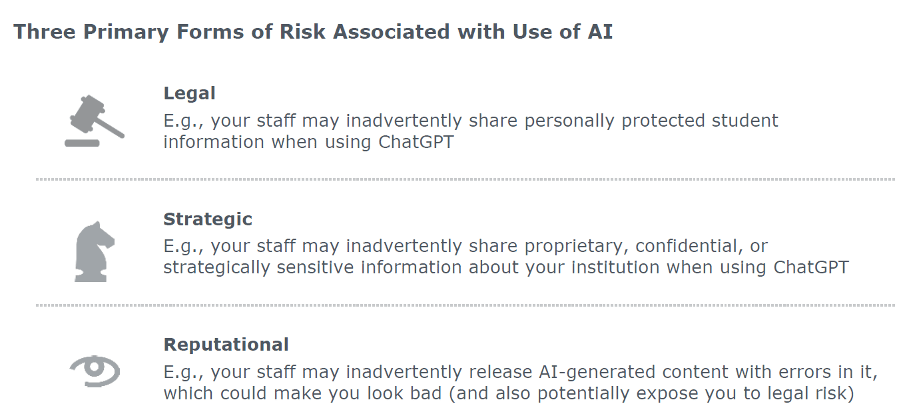4 takeaways from marketing to graduate students in 2023—and predictions for 2024
Insights from a former higher ed CMO
January 8, 2024, By Val Fox, Senior Director and Principal, Adult Learner Recruitment
I recently returned from the Windy City, where I attended the American Marketing Association’s (AMA) annual higher ed symposium. As a former university CMO, I always come away from this convening of higher ed marketers energized about the future of marketing and what it means to engage evolving adult learner audiences in the coming year. Here’s a snapshot of the key trends that emerged in 2023—and how those may shape our work in 2024.
1. Professional, Continuing, and Online units claim the spotlight
Historically, professional, continuing, and online (PCO) units operated at the periphery of university agendas. But this past year saw a renewed emphasis on integrating these units within the broader institution. For some schools, this reintegration was a way to leverage shared administrative services and thereby cut costs and make up revenue gaps from declines in undergraduate enrollment. Institutions were able to apply the online learning innovations from PCO units across the university and build lifelong learning relationships with alumni.
So, what are the implications of these changes—and how will they impact marketing to graduate and adult students in 2024?
Predictions for 2024, Based on Changes in 2023

2. AI adoption continues to evolve from experimentation to practice
In EAB and NAGAP’s September 2023 survey of 400+ graduate enrollment leaders, just 20% of respondents said their institutions use AI for their marketing and enrollment efforts. And those that do use AI on a one-off basis most often use AI tools to write or edit marketing copy. But in 2024, AI will become increasingly embedded in enrollment teams’ day-to-day work. We’re seeing some early adopters use AI to review application essays or automate website analysis work. I also expect that enrollment marketing teams will increasingly use artificial intelligence capabilities embedded in CRMs, like Slate’s features list and Salesforce’s Einstein GPT.
Given how quickly the AI terrain is evolving, enrollment teams will need to figure out the role they would like AI to play in their work moving forward—and quickly. In 2024, this should include a focus on educating admissions, marketing, and enrollment staff about responsible AI use. Our research team has found the following as the primary risks of AI use to enrollment teams:

Predictions for 2024:
In 2024, new AI priorities will emerge across the institution. For example, marketing leaders will work to ensure their teams have the AI literacy to create content, analyze data, and automate communication, thereby expanding team capacity. For admissions and enrollment teams, it will be important to consider if and how AI will impact your application policies. Thirty-nine percent of the enrollment leaders we surveyed said that students’ use of AI has made it harder to get an accurate read of their abilities.
READ MORE ABOUT THE IMPLICATIONS OF NEW AI FOR ENROLLMENT LEADERS
3. Slow, long-term marketing outreach gains traction
Marketing teams have long subscribed to the idea that “speed to lead” is king, putting operations in place to support immediate follow-up calls and text messages. But student behavior is changing—and marketers are taking note. For example, we’re seeing a slow, drawn-out decision cycle among prospective students. In our 2023 survey of nearly 4,000 graduate and adult learners, 43% of respondents said they spent at least one year researching graduate programs before applying and 24% take more than 18 months. Savvy enrollment teams can leverage AI to scale production of marketing assets (emails, digital ads, etc.) across a much longer decision timeline.
EXPLORE MORE FINDINGS FROM OUR STUDENT SURVEY
At the same time, we’re seeing a growing number of students rely on recruitment emails from colleges and universities to learn more about going back to school. Twenty percent of students we surveyed said they referred to emails from colleges and universities during their search process, up from 13% in our 2021 survey. We’re also seeing younger students rely on email. Our 2023 survey of current high school students indicated that 75% want to hear from schools via email.
TIPS TO IMPROVE YOUR RECRUITMENT EMAILS
Predictions for 2024:
Marketing and enrollment teams will shift resources from “speed to lead” outbound calls to content creation and multi-channel outreach in support of longer, more dynamic, and more responsive student journeys.
4. Marketing messages focused on support make a difference
In 2024, Gen Z will account for 31% of the total adult learner market—and growing. By 2031, Gen Z will be 60% of the adult learner market. Your marketing messages will need to speak to Gen Z’s mindset, priorities, and needs.
Mental health challenges among Gen Z students have been well documented. As those students matriculate into our graduate and adult education programs, we will need resources in place to support them. Marketers will need to understand mental health drivers and message that in student outreach. Schools that highlight support services—including mental health resources and career services—in their recruitment outreach will gain an advantage, especially with younger applicants. And you can support students long before they even enroll, including connecting students to application support early on in your outreach.
WHY WE SHOULD BE TALKING MORE ABOUT GRADUATE STUDENT SUCCESS
In particular, our surveys of graduate and adult learners also indicate students prioritize online support services when making enrollment decisions. If you offer support services designed specifically for online students, make sure to highlight those on program webpages and across your other marketing materials.
Predictions for 2024:
Mental health resources will need to expand from undergrad-centric services to support graduate, online, adult degree completer, and continuing education students. Institutions with strong offerings in these areas—and who message these support services as a unique differentiator—will have a window to capitalize on this differentiator before others catch up.
As we prepare for 2024, enrollment marketers will need to adopt a marathon mindset to engage ever-expanding adult learner audiences with hyper-personalized messages for years, not months. Early adopters of new tools, messaging, and mindsets will win over prospective students in the years to come.

More Blogs

3 things you need to know about the shifting adult learner market

How Houston Baptist University tripled graduate student enrollment
